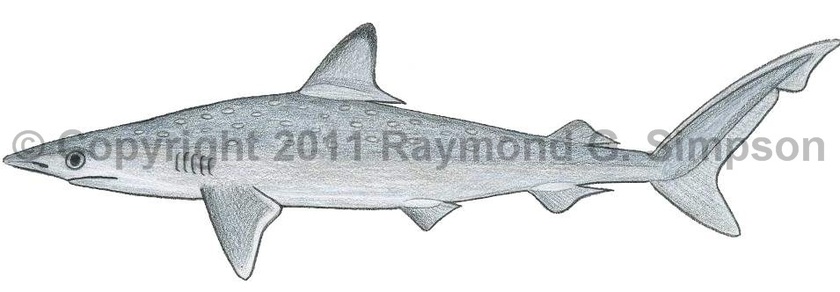
Common Name
Atlantic Sharpnose Shark
Year Described
Richardson, 1836
Identification
Anteroposterior tooth rows: 11-13/12-13 on each side; 24-27/24-27 total
Vertebrae: 56-66 precaudal, 126-144 total (precaudal equal or less than caudal centra)
A small shark with a slender body. Snout long and flattened, with a pointed tip. Eye large. Distance between nostrils 1.5-1.7 times in pre-oral distance. Nasal flaps triangular and low. Upper labial furrows long and well developed. A low interdorsal ridge is present. A long paired preanal ridge present. No keels on caudal peduncle. Gill slits short (2.2-2.5% TL). Teeth in upper jaw broad-based with low, very oblique cusps. Lower jaw teeth similar to upper. First dorsal fin fairly high (7.4-9.2% TL) with a straight anterior margin, a rounded tip, and inserted over free tip of pectoral fin. Second dorsal fin smaller than first (1.9-2.5% TL) and inserted over anterior half of anal fin base. Both dorsal fins with extended free posterior tips (second dorsal free tip over twice height of second dorsal). Anal fin similar in size to second dorsal fin. Pelvic fin inserted midway between anal and dorsal fin. Pectoral fin small and broad, with rounded tips.
Color
Gray to brown above, grading to whitish below. Larger specimens with white spots on dorsum. Dorsal fins with dusky tips. Pectoral fins have a narrow white margin.
Size
Mature adults from 65-90cm TL (females average larger). Newborns from 29-37cm. Maximum size to over 110cm TL.
Habitat
Continental waters from 1-280m, but much more common in shallow coastal waters and estuaries. Found in the surf, inlets, bays, marsh channels, and harbors. Can tolerate low salinities but not in freshwater.
Range
Canada to S. Florida, and the Gulf of Mexico to Honduras.
References
Castro, J.I. 2011. The Sharks of North America. Oxford University Press, 640 pp.
Compagno, L.J.V. 2002. Sharks. In: Carpenter, K.E. (Editor) FAO Identification Guide for Fishery Purposes. The Living Marine Resources of The Western Central Atlantic. Volume 1: Introduction, mollusks, crustaceans, hagfishes, sharks, batoid fishes, and chimaeras. ASIH Special Publication No. 5. FAO, Rome.
Compagno, L., M. Dando, and S. Fowler. 2005. Sharks of the World. Princeton University Press, 480 pp.
Other Notes
Replaced by R. lalandii and R. porosus in the Caribbean and off S. America.